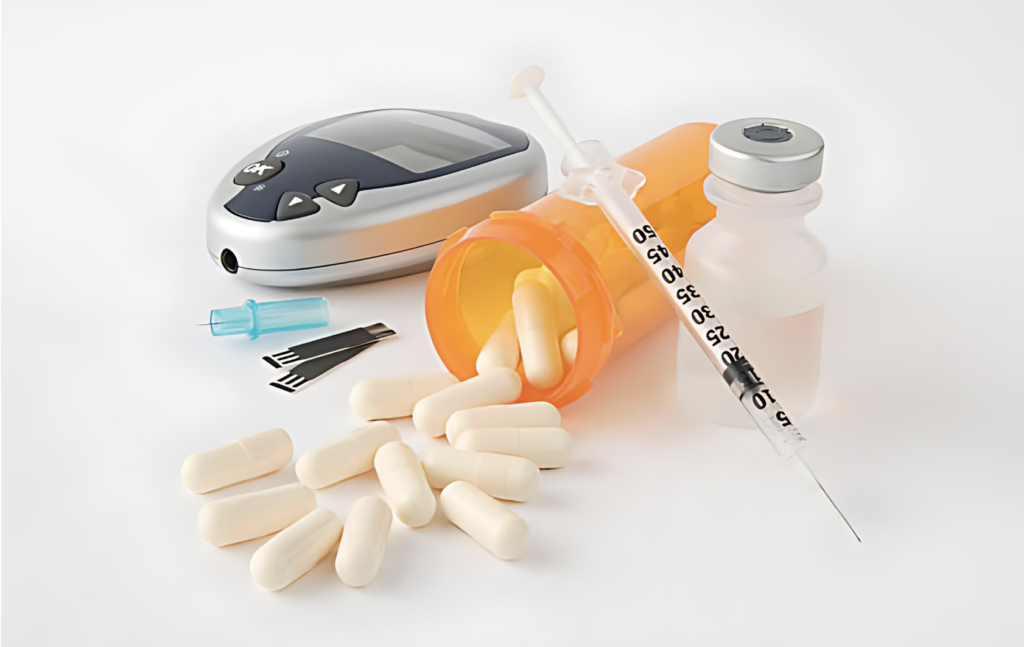Health, Health Conditions
How to Diagnose and Treat Type 2 Diabetes?
There are millions of people all around the world who suffer from type 2 diabetes, a chronic and extensive disease. Diabetic ketoacidosis develops when insulin is either not produced adequately or when the body tries to ward off its effects. Diagnosing and effectively treating type 2 diabetes is crucial for patients and healthcare providers alike due to the disease’s prevalence and the serious complications it can cause.
The key to successfully treating type 2 diabetes is an early diagnosis. There are a number of diagnostic tests that can be used to learn more about a person’s blood sugar levels. It is much easier to manage the problem if you know the warning signals and when to contact a doctor.
Treatment, after a diagnosis has been made, is a mix of approaches that are customized to meet the specific requirements of each patient. Methods for managing blood sugar levels and reducing the likelihood of problems include both behavioral changes and pharmaceutical therapies. Regular monitoring and continuing communication with healthcare providers are essential components of an all-encompassing strategy for the effective management of type 2 diabetes.
This article provides an in-depth look at the procedures involved in treating type 2 diabetes by diving into the processes of diagnosis and treatment.
Whether you’re just getting your diagnosis or are looking for ways to help a loved one cope, this article will help you comprehend type 2 diabetes and all its intricacies.

Fasting Plasma Glucose Test(FPG)
Purpose
The Fasting Plasma Glucose Test (FPG) measures blood sugar levels after an individual has fasted for at least eight hours. This test is especially valuable since it measures the body’s ability to maintain normal blood glucose levels in the absence of food.
Procedure
Timing: The FPG test is normally performed in the morning following an overnight fast.
Preparation: Patients are advised not to eat or drink anything except water for at least eight hours prior to the test.
Blood Draw: A healthcare worker takes a blood sample from a vein, typically in the arm.
Analysis: A blood sample is sent to a laboratory and examined to determine glucose levels.
Interpretation
Normal fasting blood sugar level: < 100 mg/dL.
Prediabetes is characterized by a fasting blood sugar level of 100 to 125 mg/dL. This range indicates an increased chance of getting diabetes, but it does not confirm the diagnosis.
Diabetes is diagnosed when a blood sugar level of 126 mg/dL or above is measured on two different occasions. Consistently high fasting blood sugar levels indicate that the body is not adequately managing glucose.

Random Plasma Glucose Test (RPG)
Purpose
The Random Plasma Glucose Test (RPG) measures blood sugar levels at any time of the day, regardless of when the individual last ate. This test is often used when a quick diagnosis is needed, especially if symptoms of diabetes are present.
Procedure
- Timing: Blood can be drawn at any random time, making it a flexible option for testing.
- Preparation: No special preparation or fasting is required, allowing for immediate testing.
- Blood Draw: A healthcare professional collects a blood sample from a vein.
- Analysis: The sample is analyzed to measure the glucose concentration.
Interpretation
Diabetes Indication: A blood sugar level of 200 mg/dL or higher suggests diabetes, especially if the test result is accompanied by classic symptoms such as:
Increased Thirst
Description: Persistent and excessive thirst, known as polydipsia, is a common symptom of diabetes.
Reason: High blood sugar levels cause the body to draw water from tissues, leading to dehydration and an increased need to drink fluids.
Frequent Urination
Description: Frequent urination, or polyuria, is another hallmark of diabetes.
Reason: The kidneys attempt to filter out the excess sugar from the blood, resulting in more urine production. This often leads to a need to urinate more frequently, including during the night.
Unexplained Weight Loss
Description: Significant weight loss without changes in diet or exercise can be a symptom of diabetes.
Reason: When cells are unable to access glucose for energy, the body starts breaking down fat and muscle for fuel, leading to weight loss.
Fatigue
Description: Persistent tiredness or fatigue is a common symptom experienced by individuals with diabetes.
Reason: The body’s inability to effectively use glucose for energy leads to a constant feeling of tiredness, regardless of adequate rest.
Blurred Vision
Description: Blurred vision is a symptom that may indicate diabetes.
Reason: High blood sugar levels can cause the lenses of the eyes to swell, leading to changes in vision and difficulty focusing.

A1C Test (Hemoglobin A1C or HbA1c)
Purpose
The A1C test, also known as Hemoglobin A1C or HbA1c, provides an average of an individual’s blood sugar levels over the past two to three months. It measures the percentage of glucose attached to hemoglobin, the oxygen-carrying protein in red blood cells. This test is valuable for providing a long-term picture of blood sugar levels.
Procedure
- Timing: The A1C test can be performed at any time of the day.
- Preparation: No fasting or special preparation is required, making it convenient for patients.
- Blood Draw: A healthcare professional draws a blood sample.
- Analysis: The sample is analyzed to determine the percentage of hemoglobin that is glycated (coated with sugar).
Interpretation
- Normal A1C Level: Below 5.7%.
- Prediabetes: An A1C level between 5.7% and 6.4%. This range indicates a higher risk of developing diabetes.
- Diabetes: An A1C level of 6.5% or higher on two separate tests confirms a diagnosis of diabetes. This indicates that blood sugar levels have been consistently high over the past few months.
Additional Considerations
While the FPG, RPG, and A1C tests are the primary tools for diagnosing type 2 diabetes, healthcare providers may also consider additional tests and factors in specific cases.
Oral Glucose Tolerance Test (OGTT)
- Purpose: The OGTT assesses how well the body processes glucose.
- Procedure: After fasting, the patient drinks a glucose-rich beverage. Blood sugar levels are measured at intervals over the next two hours.
- Interpretation:
- A level of 140 to 199 mg/dL two hours after drinking the solution indicates prediabetes.
- A level of 200 mg/dL or higher confirms diabetes.
Autoantibody Blood Test
- Purpose: To differentiate between type 1 and type 2 diabetes by detecting specific autoantibodies typically present in type 1 diabetes.
- Procedure: A blood sample is analyzed for the presence of these autoantibodies.
- Interpretation: The presence of autoantibodies suggests type 1 diabetes.

Treating Type 2 Diabetes
Diabetes type 2 is a condition that can be managed, despite the fact that there is presently no treatment for the disease. The therapy for type 2 diabetes generally consists of making adjustments to one’s lifestyle, monitoring one’s blood sugar levels, and taking medication.
Alterations to One’s Way of Life
Modifications to one’s way of life are crucial in treating type 2 diabetes. Among these modifications are:
Regular Physical Activity
Engaging in regular physical activity helps lower blood sugar levels, promotes weight reduction, improves blood flow and blood pressure, raises energy levels, and assists in the management of stress. Engaging in physical activity also helps improve blood pressure. Your goal should be to engage in physical exercise of at least 150 minutes per week at a moderate level.
Prior to beginning any kind of fitness program, it is important to discuss it with your healthcare physician to make sure that it is safe and appropriate for your condition.
Healthy Diet
Your diet should be healthy, and you should work with a qualified dietitian to create a meal plan that is specific to your requirements. The consumption of a diet that is well-balanced and contains lean proteins, vegetables that are low in starch, healthy fats, and complex carbs can assist in the regulation of blood sugar levels. Additionally, it may be good to keep track of the amount of carbohydrates consumed and select foods that have a low glycemic index.
Weight Management
Keeping a healthy weight is vital because it can enhance insulin sensitivity and overall blood sugar control. Weight management is the process of maintaining a healthy weight. When it comes to controlling type 2 diabetes, even a small amount of weight loss, such as five to ten percent of your body weight, can make a major difference.
Quit Smoking
The risk of complications connected with diabetes, such as cardiovascular disease, is increased when smoking is allowed to continue. Quitting smoking can improve your general health and make your diabetes management strategy more effective. There are several benefits to quitting smoking.
Blood Sugar Monitoring
It is essential for people who have type 2 diabetes to test their blood sugar levels on a regular basis. It helps them make informed decisions about the amount of food they eat, the amount of physical exercise they get, and the dosage of their medications, and it provides crucial insights into how well their present treatment plan is working. The following methods can be used to monitor blood sugar levels:
The Glucose Meter and Finger Stick: This technique includes pricking your finger in order to acquire a blood sample, which is then evaluated using a glucose meter. It is a standard method that is dependable for monitoring the levels of sugar in the blood.
Continuous Glucose Monitor (CGM): A CGM is a device that continuously measures glucose levels in the interstitial fluid. It provides data in real time. This monitoring occurs throughout the day and night. By providing you with alerts when your blood sugar levels are high or low, it can assist you in managing your diabetes in a more efficient manner.

Medications
It is possible that medication will be required in treating type 2 diabetes in addition to making adjustments to one’s lifestyle and monitoring one’s blood sugar levels. Some examples of medications are:
Metformin
Metformin is frequently the first medicine administered for type 2 diabetes. It works to lower blood sugar levels by lowering the amount of glucose that is produced in the liver and by enhancing insulin sensitivity.
Sulfonylureas
These drugs are known to drive the pancreas toward producing more insulin.
Inhibitors of DPP-4
These have the ability to lower blood sugar levels without producing a drop in blood sugar levels.
GLP-1 Receptor Agonists
The drugs contribute to a reduction in blood sugar levels while also slowing digestion.
SGLT2 Inhibitors
These are known to assist the kidneys in eliminating sugar from the body through the urine.
Insulin Therapy
In certain circumstances, insulin therapy may be necessary in order to properly maintain blood sugar levels.
Considering that every person with type 2 diabetes is unique, treatment regimens ought to be tailored to the specific requirements and medical conditions of each individual receiving therapy. Maintaining regular appointments with your healthcare team will be of great assistance in modifying your treatment plan in order to obtain the best possible management of your diabetes.
Disclaimer: Please note that Discoverybody has taken great care to ensure that all information provided is comprehensive and up to date. However, you should not use this article as a substitute for the expertise that a licensed healthcare professional can offer. It’s always a good idea to talk to your doctor before taking any medication.
Sources Expanded:
- Diabetes Types, Testing and Diagnosis. (n.d.). Froedtert & the Medical College of Wisconsin. https://www.froedtert.com/diabetes
- Type 2 Diabetes: Symptoms, Causes, Treatment. (2023b, June 25). WebMD. https://www.webmd.com/diabetes/type-2-diabetes
- Diabetes – Diagnosis and treatment – Mayo Clinic. (2024b, March 27). https://www.mayoclinic.org/diseases-conditions/diabetes/diagnosis-treatment/drc-20371451
- Diagnosing Type 2 Diabetes. (n.d.). NYU Langone Health. https://nyulangone.org/conditions/type-2-diabetes/diagnosis
- Professional, C. C. M. (n.d.-i). Type 2 Diabetes. Cleveland Clinic. https://my.clevelandclinic.org/health/diseases/21501-type-2-diabetes
- Pietrangelo, A. (2023, January 23). Understanding Type 2 Diabetes. Healthline. https://www.healthline.com/health/type-2-diabetes
Trusted Health, Wellness, and Medical advice for your well-being



